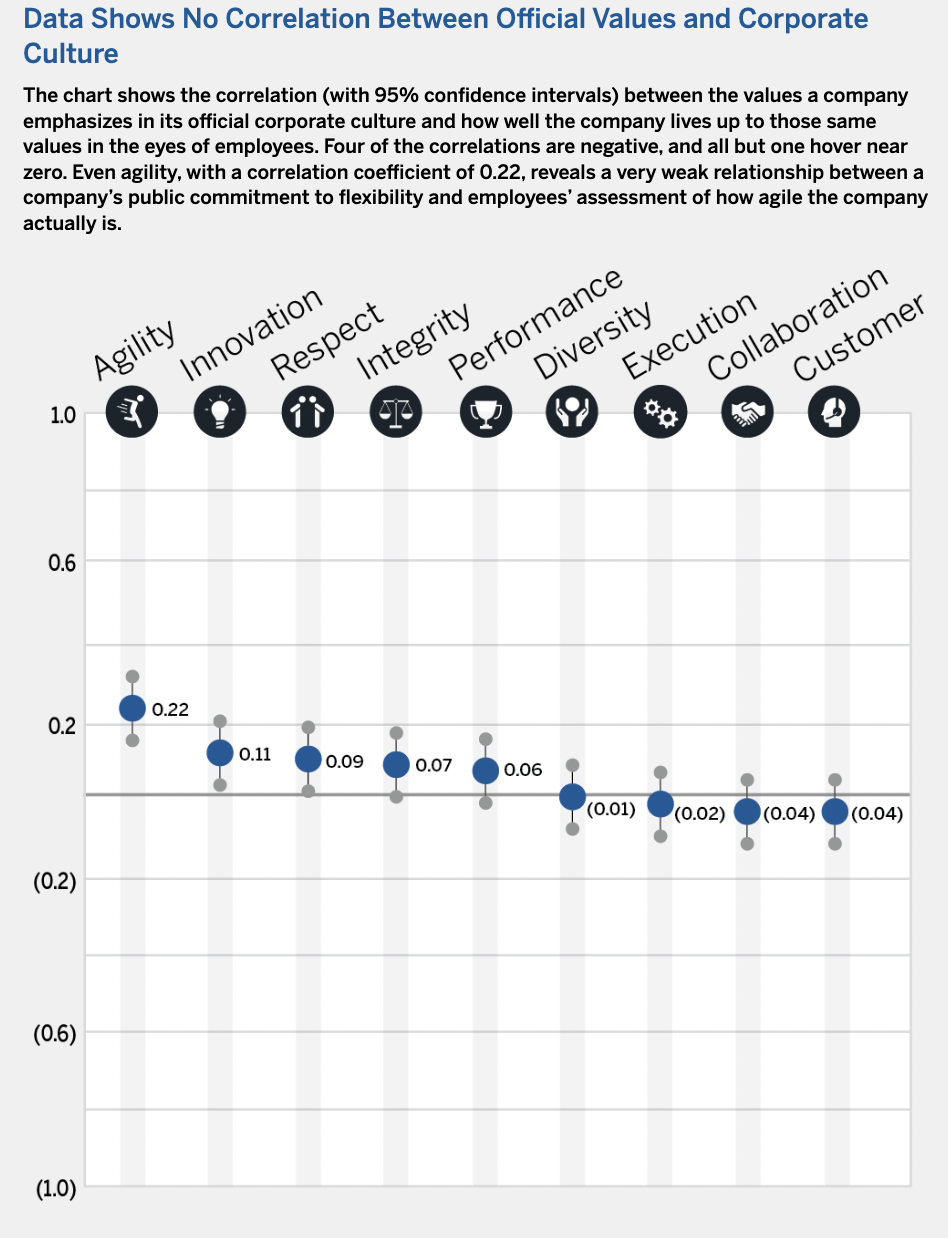
Did you know: there are about 50 different definitions of corporate culture in academic literature?
Most of the definitions out there have something in common…
Values.
Values are often seen as the foundation of culture and the way to inform and guide employee behavior.
Hot take: values can be a bunch of corporate jargon BS.
And at most places they are.
Don’t believe me?
The data has shown there is no correlation between values a company emphasizes and how well a company lives up to those values in the eyes of the employee.
Take a look:

Truly, not shocked.
4 values had a negative correlation:
- Customer orientation
- Collaboration
- Execution
- Diversity
So, the question remains: do company values actually matter?
It depends.
It’s clear there is a disconnect between what companies say they value and what employees actually experience.
But, what a company ultimately chooses for their values can tell you so much about the identity of the organization and what the company aspires to be.
JOIN 130K+ HR LEADERS
Get insights, learnings, and advice on how to build companies and cultures that people actually love.
No spam. Unsubscribe any time.
So how can you effectively implement values?
Here are some do’s and don’t of values to help close the gap between values and the employee experience.
The Do’s of values:

Here are 3 do’s of values to ensure they are effectively implemented:
- Be action oriented. I hate when I see values like innovation or integrity. Yes, those things are great but they’re also open for interpretation.
Your values should include examples. Employees need to understand how that value is being interpreted.
Here are 45 examples of company values and behaviors to pull from!
- Communicate, communicate, communicate. When’s the last time your company mentioned values to all the employees?
Effective communication will be the key to the success of your values. But oftentime, we aren’t consistent about communicating values. We set them once and forget about them! Been there, done that!
And, covering values in onboarding, isn’t enough.
To close the gap between words and actions you need to highlight to employees how values show up in day to day operations.
A great framework for how to communicate values to your employees is to:
- Define the value
- Give examples of how this valued was displayed
- Example WHY this value matters (usually how this value leads to better environment and/or company performance)
Moments like weekly meetings, monthly town halls or company retreats are great moments to reiterate and celebrate your values.
BTW: What are your leaders doing? They play a MAJOR role here. Are your leaders living your values? Because employees are looking to leadership to understand how to behave. More on this next week!
- Less is more. The average organization has 5 values but IMO even that may be too many. If your employee can’t easily list your values then you’ve gone too far.
The more you can hone in on your values the better. It can be intimidating to say these are 3 things we stand for but it’s better than listing 10 and only halfassing them.
Having a concise set of values is also less overwhelming for your employees and they’ll be easier to reinforce!
Aim for 3 to 4. If you have more, consider: is there any overlap or conflicts? Probably.
Those are 3 things to consider doing when implementing and evolving values.
Now, what shouldn’t we do?
The Don’ts of values:

Ahh, the don’ts of values. Here are 2 things I recommend you NOT do when it comes to values.
- Forget to integrate your values into your processes. Do your values show up in:
- Hiring
- Performance management
- Employee recognition and rewards
- Promotions
If not, you may be missing opportunities to continue to highlight your values!
Values are not just a one time thing. If you want your employees to adopt your values then it should show up in all parts of the employee experience.
For example in hiring: you should share your company values with any prospective candidate and ask if they have any questions. You could also tailor questions to align with your values but just be careful because hiring can be riddled with bias!
- Use your values inconsistently. There can be a dark side to values when they’re inconsistently used. Like when values are selectively enforced or worse, interpreted differently for certain groups.
A common example? A top performer’s behavior is in conflict with the values set but they drive revenue or work on a high profile project. Their behavior is excused and the individual isn’t held accountable.
Employees lose all trust in the organization and their HR team when things like this happen.
To resolve this situation: make sure you have alignment from your leadership team about the implications of an employee not embodying the corporate values.
Further reading: this resource outlines some characteristics of white supremacy culture that show up in organizational values. I HIGHLY encourage you to read this and cross examine your organizational values to see if any of these characteristics appear. This resource also lists antidotes and a ton of good examples for how to build better workplace cultures.
Wrapping it up:

Values can have a positive impact on corporate culture when:
- They are action orientation – think verbs!
- They are communicated regularly
- They are integrated into the employee experience
- Your leaders are also on board
- There is alignment between HR <> leadership on what happens when an employee’s (including leaders!) behavior is in conflict with the values.
The values we discussed above are the public values an organization sets.
But what about the unspoken values? More on that next week!


